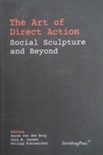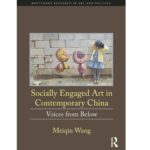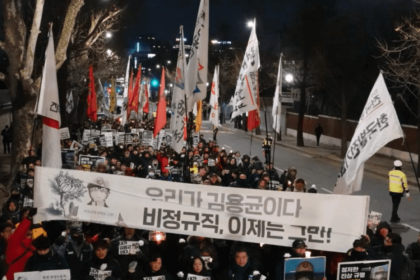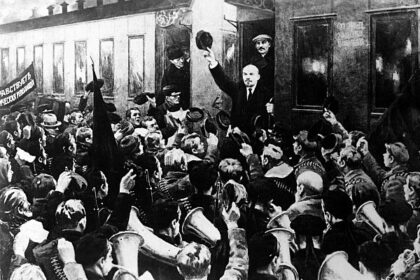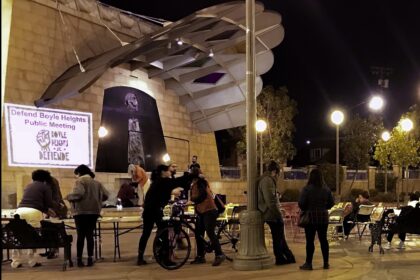Karen van den Berg, Cara M. Jordan, and Philipp Kleinmichel, eds., The Art of Direct Action: Social Sculpture and Beyond (Berlin: Sternberg Press, 2019)
Paloma Checa-Gismero
Since the turn of the century, art practices that intervene in the social fabric aiming to enact positive change have moved to center stage in the artworld. Dismissed as peripheral, underground, para-institutional, or amateurish during the 1990s, these expressions of a practical aesthetic now populate biennials, museums, city commissions, and higher education curricula. A growing body of academic literature has mirrored this shift in the last decade, building a field of expertise as its object of study unfolds in present history. Yet these practices remain uneasy analytical objects for the broader discipline of art history, where competing theories of modernism and changing methodological agendas negotiate their own relation with this art form that, in essence, problematizes the discipline’s assumptions about art’s autonomy and its potential to either prefigure or support processes of social change.
Important theoretical studies of the past two decades have problematized the historiography of modernism and avant-garde art with evaluations of socially engaged art as it relates to questions of autonomy, form and criticality. From diverging perspectives, titles such as Conversation Pieces (Grant Kester, 2004, 2013), The One and the Many (Grant Kester, 2011), Dark Matter: Art and Politics in the Age of Enterprise Culture (Greg Sholette, 2011), Artificial Hells (Claire Bishop, 2013), and Revolutionary Time and the Avant-Garde (John Roberts, 2016) form the backbone of a diverse discursive and practical artistic field. To these we can add more recent titles that explore the pedagogical potential of socially engaged art (Art as Social Action, Greg Sholette, Chloë Bass, eds., 2017) and the exhibition histories of this form (Exhibition as Social Intervention. ‘Culture in Action’ 1993, Joshua Decter, Helmut Draxler, eds., 2014). The Art of Direct Action. Social Sculpture and Beyond joins this thriving conversation and invites audiences to contemplate the trans-Atlantic avant-garde influences that are woven into socially engaged art’s histories.
Edited by Karen van den Berg, Cara M. Jordan and Philipp Kleinmichel, The Art of Direct Action. Social Sculpture and Beyond (Sternberg, 2019), centers on the influence that the term ‘social sculpture,’ coined by German artist Joseph Beuys, has had in contemporary art practices that exit the exhibition space to engage in political and community action. Beuys occupies a central position throughout the book. A set of five essays by leading scholars of socially engaged art provide a theoretical and historical grounding for Beuys’s legacy today; eleven interviews with living artists and curators explore the practiced adaptations that the Beuysian form has taken on in today’s global contemporary art world.
A common thread throughout the book concerns the challenges that today’s late capitalism presents for any form of social and cultural action that seeks to incite beneficial social change. This is an economic and political landscape very different from the one in which Beuys first developed his concept of ‘social sculpture’. These concerns lead the book’s contributors to examine issues of artistic autonomy in socially engaged art practices, and revisit earlier debates that focused on the tension between political engagement and autonomy in West Germany and the U.S. during the 1960s and ‘70s. Another set of concerns, evident throughout the chapters, is the unveiling of concealed kinships between Beuys and other art practitioners, both among his contemporaries and in the present. Although these causalities might at times feel forced in the interviews, the leading hypothesis is a valid provocation supported by several cases in which Beuys incited direct artistic reactions—positive and negative—such as in the case of second wave feminist artists like Leslie Labowitz and artists from younger generations like Daniel Joseph Martinez.
The book is at its best in several of the essays, where authors find room to defend the relevance of the political legacy of the 1960s and 1970s amidst today’s very different political and representational scenarios. In her introduction and first chapter, “Socially Engaged Art and Fall of the Spectator since Joseph Beuys and the Situationists,” Karen van den Berg evaluates the status of socially engaged art under “semiocapitalism” (borrowing Franco Berardi’s term). In this landscape, she argues, socially engaged art is something more than yet another avant-garde-ism. It is a “tendency that brings about a repositioning of artistic action at large and leads to a fundamentally different understanding of art in society”.[1] To explain this phenomenon, van den Berg maps a classification of different project types that currently fit into the category of socially engaged art. The groups include: “art projects about refugee issues,” “‘spectator art’ that integrates refugees as performers,” and “collaborative projects with refugees beyond the gallery nexus”. Van den Berg’s classificatory criteria consider the relationship of these works to art institutions, audiences, and the roles of different actors within projects. In the first group she situates the work of highly visible artworld figures such as Ai Weiwei (2016), designed for art audiences and reliant on their potential to bridge broader public conversations with internal debates intrinsic to the art institution. To the second group belong projects that still reproduce the modernist authorship paradigm, incorporating refugees as actors within the performance. An example of this category is Olaffur Eliasson’s Green Light Workshop at the 57th Venice Biennial (2017). Within the third group van den Berg distinguishes between ‘therapeutic projects’ that place refugee subjects in the position of the patient and hope to rehabilitate their agency (Hannah Rose Thomas and Dr. Sarah Whittaker-Howe’s workshops with former ISIS slaves), and projects in which refugees become, instead, co-authors (Silent University, 2016). In these types of projects, non-art actors apply artistic strategies to enhance social cohesion. Next, van den Berg mentions projects that do not rely on the existence of an art spectator and stress, instead, the importance of social gathering as a desirable outcome in itself (Coop Campus Berlin, 2015). Last, are projects that take art institutions as spaces for social intervention, and that wield the institution’s social and symbolic capital to advertise their actions as exemplary. In her analysis, van den Berg favors those projects that do not rely on art spectatorship because, in her view, they are more capable than others of enriching and strengthening the social commons before the neoliberal threats that they face. Her categorization of current socially engaged forms is a clear and useful one, and it could be easily assigned for an intro level course on the subject.
In his chapter “Action and the Critique of Action in Theodor W. Adorno and Joseph Beuys,” Grant Kester grounds his revision of engaged practice in the theories of Theodor W. Adorno and Joseph Beuys. Kester reflects on current distrust within art criticism about the potential of socially engaged art to provoke positive social change. Adorno’s late life split with his long-time friend Herbert Marcuse serves as détonant moment for the chapter. Kester situates their split in the context of their discrepant responses to student activism; a division that resurfaces in today’s aesthetic paradigms. While Marcuse recognized that students’ anti-Vietnam War mobilizations at his home institution UC San Diego and those by APO protestors in West Germany might not have been ideal, he supported their practiced resistance to state violence. However, for Adorno, these forms of activism compromised the autonomy of intellectual work—to the extent that the philosopher drew upon police intervention to enforce this distinction. Adorno considered student activism as mere “actionism,” a form of situational practice that lacked theory’s supposed prefigurative capacity. His dislike of spontaneity re-enacts former condemnations by statemen and strategists, in contrast with Beuys’s reliance on it. Anticipating contemporary rehabilitations of Adorno’s posture, Kester explains that “any existing artistic practice that rejects or challenges Adorno’s model of formalist criticality can easily enough be reduced to another instance of actionist naivete or overt complicity with capitalist domination” by some bastions of today’s art criticism.[2] Given the proletariat’s failure to organize and stop the advance of totalitarianism—in its fascist or capitalist versions—Adorno’s entrenched defense turns artists and intellectuals into deputies for the masses. As counter-model, Kester offers Beuys’s ‘permanent conference,’ an extended body of non-objectual work that included his institutional and pedagogical practice. This durational fraction of Beuys’s repertoire aligns with student activism in West Germany in the 1960s and 1970s and includes projects such as the Referendum and founding of the Organization for Direct Democracy (1970), the occupation of the Dusseldorf Art Academy (1971), and the creation of what would become the Free International University for Creativity and Interdisciplinary Research (1973). This line of work took the organization of alternative socialities as medium and purpose, transforming the role of the artist from a maker of objects to a participant in processes of societal and cultural change.
Using Beuys’s practice as counterpoint for Adorno’s theory helps Kester advance a further criticism of a century old malady: the widespread tendency among art critics to disregard socially engaged art practices that occur within capitalism as inherently deactivated and co-opted due to their inscription within a hegemonic capitalist system. In his view, this posture produces a dichotomy between artworks built around agonism and those that seek consensus. This binary overlooks the potential of all forms of socially engaged practice to generate new knowledge and transform consciousness, and places all forms of artistic creation in an inherently utilitarian relationship with capitalist power. For Kester, these critical tropes emerged in response to performative iterations of socially engaged practices inscribed in the gallery or biennial circuits—exhibitionary standards that were initially conceived to uphold object-based art forms—and have been projected onto artistic practices developed outside of art world institutions, which require very different analytic criteria. In his words: “The space of cognitive indeterminance (the work of art as hermeneutically resistant) so central to earlier models of avant-garde aesthetics has been displaced by a causal mode of indeterminance (the work of art as a rhetorical gesture that may or may not do anything more than reinforce the growing monetization of contemporary art)”.[3] Kester closes his essay calling for a need to focus criticism’s analytical eye on the specificity of artworks rather than on the a priori given theoretical models that they supposedly adjust to.
In her chapter “Joseph Beuys and Feminism in the United States” Cara M. Jordan investigates the parallels in the production of Joseph Beuys and U.S. feminist artists of the 1970s and 1980s. Jordan draws from rich evidence gathered through extensive archival research and interviews, helping readers envision the actual encounters between Beuys and U.S. feminists as they took place at both sides of the Atlantic. These include a dinner organized by Beuys’s gallerist Ronald Feldman, which included big names in the New York feminist art scene like Lucy Lippard, Faith Ringgold, Yoko Ono and Cindy Nemser, and Beuys’s first public discussion in the U.S., at the New School for Social Research, attended by figures such as Holly Solomon, Phillip Glass, and Douglas Davis. Jordan’s exploration is motivated by an interest in the similarities in the goals and methods in both bodies of work, despite a baseline antagonism towards Beuys’s persona among U.S. feminist circles, motivated by what they perceived as his male-centric individualist, preacher-like attitude. Beuys was seen as antithetical to the horizontality of consciousness raising groups and other methodologies of collaborative meaning-making popular in second wave feminist circles. The feminists’ reluctance to embrace Beuys was due in part to his identification by international art publications with the work of male Conceptualist artists. This categorization favored Beuys’s object and installation-based work, more suited for the gallery, over his pedagogical and activist performances, oriented towards political action. In addition, the two sides showed important theoretical discrepancies: while Beuys was aligned with German Marxist groups—especially with student and environmental activists—U.S. feminists were engaged in localized struggles such as anti-Vietnam War movement and reproductive rights activism.
One of the parallels that Jordan highlights are the commonalities between Beuys’s work and a group of women artists such as Judy Chicago, Suzanne Lacy and Judith Baca. Yet it is Leslie Labowitz who most directly connects U.S. second wave feminism with Beuys’s work through a series of convergences that Jordan convincingly illustrates by analyzing Labowitz’s most well-known works. In the later section of the chapter, Jordan investigates the explicit references to Beuys in 1990s feminist and activist art, briefly discussing the work of Suzanne Lacy, Mary Jane Jacob, Mark Dion, Daniel Joseph Martinez and Dorit Cypis. She also touches on Beuys’s influence on environmental artists such as Mierle Laderman Ukeles. I must blame the understandable spatial restrictions of published scholarship for Jordan’s brevity in this important section of her essay. Dorit Cypis receives more attention, especially with regards to the project Kulture Klub. An interview between Jordan and Daniel Joseph Martinez expands this fraction of her essay later in the book.
Philipp Kleinmichel’s suggestive chapter, “The Symbolic Excess of Art Activism,” proposes a solution for contemporary debates about the political value of politically oriented art practices that recovers past emphasis on the institutional nature of art. He describes a shift from their aesthetic to their political potential in these debates, and directs our attention in two directions: On the one hand, he invites us to consider the changes of orientation within politically engaged art through time and its immutable inclination to intervene in the political. On the other, he suggests we dissect the slight differences between non-representational political engagement in the name of art and similar practices that operate under the denomination of political action. It is in the scrutiny of the slim liminality between artistic and non-artistic political activism, and the dissociation of their subjective and objective intentions, that Kleinmichel situates his understanding of the political value of artistic political activism. Kleinmichel claims that, while both approaches might be similarly capable of connecting with audiences and interpellating political constituencies, it is only politically oriented art that has the inherent potential to ‘musealize’ forms of political activism. This turn towards ‘musealization’ distances actors from activist practices so that the latter can be regarded in conditions of objectivity. Integral to this process of objectification is art’s power to institutionalize and archive the forms of political activism that it thematizes in its representations. The political, ‘museal’, practices that Kleinmichel describes are those bred in the revolutionary movements of the 1960s and 1970s, contemporary to Beuys’s program. No longer with us in today’s version of capitalism, these activist practices are actualized through their representation in politically oriented art forms. The institutional validation that art is able to confer to these forms of political action upholds their relevance amidst today’s social justice movements. Far from deactivating the political potential of activism, the institutional art world positions them in the space of our immediate historical memory, making the case for a continuity between historical struggles that, on the surface, might seem unrelated.
In “Art, Neoliberalism, and the Fate of the Commons” John Roberts sets out to evaluate the potential of socially engaged art to outline a new cultural and political agenda, often defended by its practitioners and theoreticians as a hopeful alternative to the all-encompassing growth of neoliberalism. These defenses often derive from the widely held presumption that artistic practices operating outside traditional notions of institutionality and value are capable of redrawing the social relations around them. Under this paradigm, Roberts says, artistic practice is unequivocally political. Given its capacity to avoid reproducing the forms of value produced in traditional art institutions, socially engaged art is a practice of the commons that has the potential to articulate a resistance to present neoliberal erosion of the social and natural commons. Roberts seeks to differentiate socially engaged art from other practices of defense of the commons. He classifies socially engaged art in two categories of projects that claim to work within the commons: (1) Projects that propose ideal intellectual communities, based on shared processes of intellectual dialogue, and (2) Projects where artists and non-artists work together to ameliorate or change a specific situation. These practices, Roberts claims, often reproduce the unequal distribution of power of center-periphery, skilled-unskilled, urban-rural models. For Roberts, despite their initial appearances, these two modes constitute autonomous forms of artistic practice that should be valued as such. In the rest of the chapter he sets out to explain this autonomy. He defines autonomy as “the intellectual correspondence between research, social critique, group practices, and formal open-endedness”. [4] Central to considering socially engaged art as a practice of the commons, Roberts says, is the conflict between the emancipatory drive of political art praxis and the limits to its actions coming from the contextual political structures around it. Despite their emancipatory mission, these forms are always inscribed in a division of labor where relationships between intellectuals and participants are exploitative in essence. Within the art institution the former experience a gain in symbolic and cultural capital that comes at the expense of non-artist participants.
Yet Roberts remains hopeful: socially engaged art can, in some cases, pave new avenues for action and reflection, and can possibly propose alternatives to the dominance of commodity logic as a pattern for social relations. This sliver of hope occurs when socially engaged art works propose sets of relations that are incompatible with monetary exchange (in the form of perishable relations or gifts). He proposes that we measure these practices as a new form of art, which he terms “art after ‘art in the expanded field’.” These socially engaged art practices are successful when they break with the time-as-measure of commodity form because they propose forms of authenticity that are untranslatable into market logic. Their value is not commodity value, but a community value that is necessarily measured against its purposefulness within the relations informing the social commons. The autonomy of these practices, based on their successful avoidance of market logic, secures that which happens within and against commodification. Thus, despite his necessary wariness, socially engaged art’s emancipatory potential is indeed there. For Roberts, these drives towards collaboration and participation are symptomatic of broader efforts at the collective negation of capitalist advance. They represent awareness and critique by artists of their place and role within capitalist relations of production. Regardless of the actual outcomes that these projects have, they do collaterally enact a critique of commodity forms and exploited labor within neoliberalism.
The interviews speak to the editors’ desire to scratch the surface of artists’ declared influences and invite them to consider how not so visible connections might have, in fact, conditioned the forms, values and drives that inform their politically oriented practice. In their conversations about the legacy of Beuys’s notion of ‘social sculpture’ we learn as well about the overall reception of this controversial artist among different generations of U.S. artists and curators. For example, in their interview, Jordan and Mary Jane Jacob discuss the evolution of the socially engaged art field, discussing Jacob’s posture vis-a-vis concepts like ‘social practice,’ ‘new genre public art’, and ‘socially engaged art’. Jacobs speaks about her interest in the philosophy of John Dewey, with particular emphasis on the therapeutic capacities that he attributes to art. Jordan and Jacobs discuss the conditions of curating inside and outside the museum, as well as the defining characteristics of the audience, public and participant. Also in conversation with Jordan, Daniel Joseph Martinez recalls his years working with Beuys’s disciple Klaus Rinke and his learning first-hand of the former’s theoretical and practical positions. He weights the impact of Beuys’s theories on his institutional and pedagogical practice, and elaborates on what he believes is an important distinction between ‘social practice,’ in Beuys’s work, and the forms of social practice visible in the contemporary U.S. art world. In addition to the aforementioned individuals, the fantastic roster of interviewees includes Dan Peterman, Marina Naprushkina, Rainer Rappmann, Caroline Tisdall, Gregory Sholette, Anton Vidokle, kuda.org, Pedro Reyes, and Caroline Woolard, all now canonical names in the roster of socially engaged art in the United States and Europe.
If there is an absence in the book it would be examples of theories and practiced aesthetics from outside the United States and Western Europe. It is to be expected for the work of an artist as canonical as Joseph Beuys to impact, in some ways, contemporary art making in art centers like New York City and Los Angeles. The present volume offers strong evidence to support this connection. However, for those of us concerned about art history’s centripetal nature and its inbuilt tendencies to reaffirm the centrality of Western Europe and the United States in its archive and theoretical apparatus, this omission stands out. I look forward to future explorations of how cultural and political forms beyond these circles traveled back-and-forth through Joseph Beuys’s practice during and after his lifetime. A rich addition to socially engaged art’s body of literature, this evaluation of Beuys’s impact on our aesthetic and political vocabulary is a well-written natural choice for the graduate classroom and practitioners of socially engaged art today. In conclusion, this compelling edited volume is a timely reminder of the longevity of politically oriented aesthetic debates, as it dusts off a rich archive that pivots around, and expands beyond, Beuys. The book provides us with a valuable opportunity to reconsider classic debates about art’s autonomy, value, and its potential for political action amidst urgent present struggles to counter the rapid advances of authoritarian capitalism and its sophisticated, politically oriented aesthetic apparatus.
Paloma Checa-Gismero is Assistant Professor of Modern and Contemporary Art History at Swarthmore College. She holds a PhD in Art History, Theory, and Criticism (UC San Diego, 2019) and an MFA in Arts, Production, and Research (Universidad Complutense de Madrid, 2009). She has written widely about the translations that the localized engaged art practices of Latin American artists undertake in their access to international circuits of art circulation. Currently, she is working on a book about the art institutional forms that emerge at moments of dramatic political change.
[1] Karen van den Berg, Cara M. Jordan, and Philipp Kleinmichel, eds., The Art of Direct Action: Social Sculpture and Beyond (Berlin: Sternberg Press, 2019), pp.3-4.
[2] Ibid., p.81.
[3] Ibid., p.97.
[4] Ibid., p.254.

